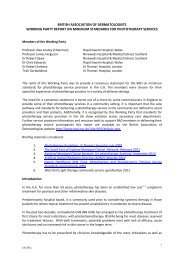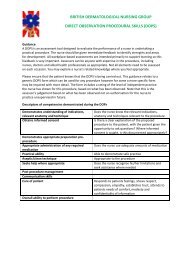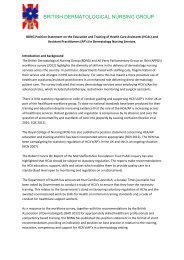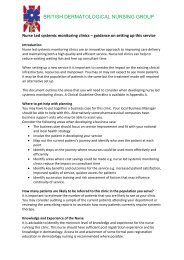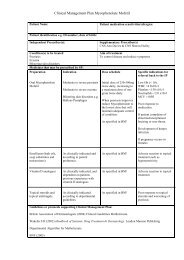Improving outcomes for people with skin tumours including melanoma
Improving outcomes for people with skin tumours including melanoma
Improving outcomes for people with skin tumours including melanoma
Create successful ePaper yourself
Turn your PDF publications into a flip-book with our unique Google optimized e-Paper software.
One systematic review based upon 12 studies found the proportion of<br />
tumour positive sentinel nodes to be 17.8% [95% CI 16.7% to 19.0%],<br />
and this proportion correlated strongly <strong>with</strong> Breslow thickness. The<br />
authors recommended that SNB is inappropriate <strong>for</strong> <strong>tumours</strong> <strong>with</strong><br />
Breslow thickness less than 1 mm, that <strong>for</strong> Breslow thickness between<br />
1.0 mm and 1.5 mm SNB should be considered on an individual basis<br />
in the light of other prognostic factors and possible adjunctive<br />
therapy, and that <strong>for</strong> Breslow thickness between 1.51 mm and 4.0<br />
mm SNB is appropriate. The authors reported that the value of SNB<br />
<strong>for</strong> Breslow thickness greater than 4.0 mm is questionable because of<br />
the high risk of existing haematogenous spread.<br />
<strong>Improving</strong> Outcomes <strong>for</strong><br />
People <strong>with</strong> Skin Tumours<br />
<strong>including</strong> Melanoma<br />
Initial investigation,<br />
diagnosis, staging and<br />
management<br />
There is evidence from observational studies that the status of the<br />
sentinel node significantly predicts disease-free survival.<br />
Evidence from observational studies suggests that, while surgical<br />
complications can arise from SNB, the procedure is less invasive than<br />
a regional lymphadenectomy.<br />
The findings of observational studies are inconsistent as to whether<br />
patients <strong>with</strong> <strong>melanoma</strong> who undergo SNB show increased rates of<br />
in-transit recurrence, compared <strong>with</strong> patients who receive delayed<br />
regional lymphadenectomy after detection of clinically palpable<br />
lymph nodes.<br />
4<br />
Lymph node clearance<br />
One systematic review found no statistically significant advantage in<br />
terms of overall mortality arising from elective lymph node dissection<br />
compared to delayed lymph node dissection at the onset of clinical<br />
symptoms.<br />
One RCT of elective versus delayed regional lymph node dissection<br />
in patients <strong>with</strong> <strong>melanoma</strong> found that the routine use of immediate<br />
node dissection had no significant impact on survival, while the status<br />
of regional nodes significantly predicted survival.<br />
Cryotherapy/cryosurgery<br />
Three UK clinical guidelines produced on behalf of the British<br />
Association of Dermatologists support the use of cryotherapy in the<br />
treatment of a sub-set of patients <strong>with</strong> Bowen’s disease, SCC (where<br />
good short-term cure rates are achievable) and primary BCC.<br />
Guidance on cancer services: <strong>skin</strong> <strong>tumours</strong> <strong>including</strong> <strong>melanoma</strong> 93




